Intel X58 Motherboard Roundup - What does $300 Get You?
by Gary Key on December 5, 2008 3:00 PM EST- Posted in
- Motherboards
ASUS P6T Deluxe
Features
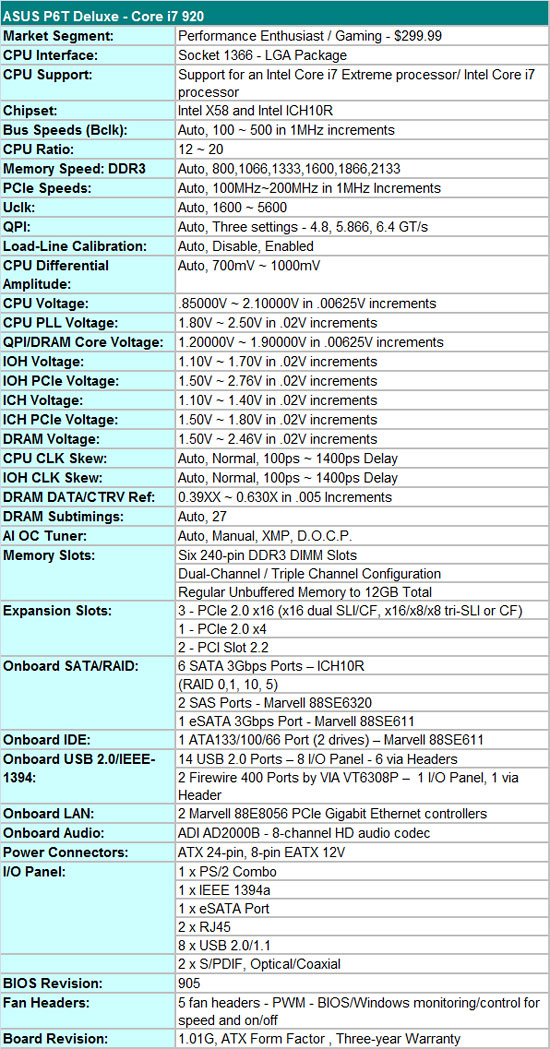
ASUS offers the P6T Deluxe in two different versions, one with the OC Palm external display module for $338 and one without for $299. The OC Palm was originally introduced as the ScreenDuo last year and features a 2.5" QVGA display, four-way directional pad, and four input buttons. It attaches to the motherboard via a USB cable and features a clean, uncluttered, and simplistic interface that allows the user to interface with various ASUS software programs. The user can monitor various hardware functions or do on-the-fly overclocking. The unit allows real-time changes to the processor's Bclk along with voltages for QPI, memory bus, and the CPU. We would like to see additional overclocking variables along with the ability to save profiles to the BIOS or real-time changes to the BIOS. Overall, it is a unique feature and fun to play with for about 30 minutes, but for most users we would suggest saving the money and buying the base board - A board that we might add is one of our favorites in the lab since it first arrived.
Not to take anything away from our other boards as they are all very good with one bordering on being great, but the ASUS P6T-Deluxe impressed us with its ability to just work as expected out of the box. While we provided several suggestions to ASUS for improvements, they mainly centered on tuning aspects, not getting basic functions to work properly before we could even consider testing. That may seem trivial, but unfortunately it is not if you are an early adopter of high-end motherboards.
The BIOS is designed for a wide variety of users who want to get the most out of a board when overclocking. Some of the voltage ranges are not as wide as Gigabyte's, nor do you have the ability to control each individual memory channel, but the options available will more than suffice for most users. We also think the ASUS BIOS is more user friendly due to the information provided for each option. However, ASUS continues to use the terminology QPI/DRAM instead of VTT as the other boards do.
ASUS features memory speeds from 800MHz to 2133MHz memory for the i920/i940 processors along with opening up QPI link speeds from a standard 4.800 GT/s up to 6.400 GT/s. We are disappointed with the number of OC profiles in the BIOS. ASUS has three OC profiles compared to up to eight on the other boards.
The board officially supports 12GB of DDR3 memory, although we expect full support for 24GB in a future BIOS release. Running 12GB of memory on this board is extremely easy and it usually requires less voltage while providing tighter timings than the other boards. Our 12GB Patriot and G.Skill DDR3-1600 kits were 24/7 stable at 1600 with 8-8-8-24 1T timings, although we needed about 1.66V for absolute stability. The Gigabyte board offered slightly better latency results with 9-8-8-24 1T timings, but the ASUS board was just slightly faster in most of the benchmarks except for WinRAR. Of course, your mileage will vary with different memory kits and sub-timings, and outside of memory benchmarks the net difference is generally less than 1%.
One last item of note, at least in this first look, is that the three PCI Express 2.0 x16 slots will operate in x16/x16 mode for 2x SLI/CF if the third x16 slot is empty. If you decide to place a PCIe RAID, network, audio, or TV tuner card in the third x16 slot, then the 2x SLI/CF configuration will operate in x16/x8 mode. We did not notice any performance differences between the two modes with our HD 4870 or GTX 260 cards. 3x SLI/CF configurations will run in x16/x8/x8 mode. You can also use the first and third x16 slots for graphics if you need to open up a PCI slot but the board will run in x16/x8 mode. Although the owner’s manual states the three x16 slots are for graphics cards only, we had no problems running our ASUS Xonar D2X or Highpoint Rocket RAID cards in x16 slot two or three.
The Board
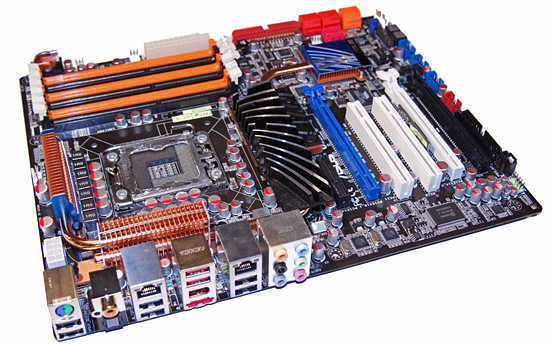
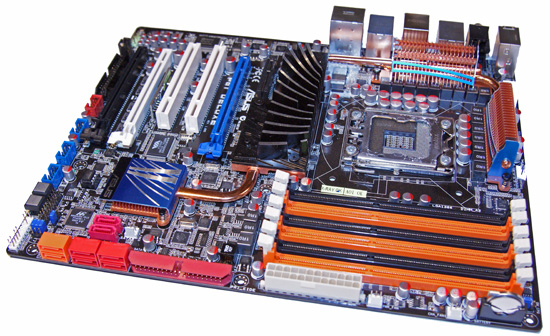
The P6T Deluxe carries over the orange and black decor from previous ASUS DDR3 boards along with a blue and white slot motif. While not exactly as colorful as previous Gigabyte boards or as subdued as the MSI board, it does work well enough; we prefer the flagship ROG color palettes. ASUS has constantly improved their layouts over time and the P6T Deluxe reflects this with a design that is virtually free of clearance problems. While not as loaded as the Gigabyte board, ASUS still has a substantial amount of items to squeeze onto the motherboard.
The first item we notice on the P6T Deluxe is the heatsink and thermal pipe setup encircling the CPU socket area. The CPU socket is centered to the DIMM slots as we noticed on the Gigabyte board. The engineers tell us this is to optimize the memory trace paths resulting in higher overclocks and improved stability. The various heatsinks are low-profile designs featuring a completely passive setup in order to keep noise to a minimum. ASUS utilizes a swept fan design for the northbridge, a small but effective fin array for the ICH10R, and a couple of relatively low-profile fin arrays for the PWM area.
All of this equates to a CPU area that is basically void of clearance issues with large air coolers, although the capacitors are little close to the 1366 socket for the more extreme cooling options. The P6T Deluxe features 23 power phases, which certainly sounds impressive, but we are still not sure if quantity is better than quality in this regard. ASUS dedicates 16 for the processor core and another three memory, two each for the memory/QPI controller and chipset. The Gigabyte and MSI boards feature two individual two-phase designs for the memory and QPI systems.
On the other end of the board we have a bevy of SATA ports and the IDE connector. The six red ports are tied to the ICH10R while the two orange ones attach to a Marvell 88SE6320 Serial Attached SCSI controller. Backwards compatibility built into the SAS standard allows current SATA drives to work. When utilizing a standard SATA drive, performance is close to the ICH10R and definitely a step ahead of the JMicron controllers on the other boards. As a plus, it will do RAID 0 and 1 arrays, and ASUS includes SAS cables in the box. We appreciate the right angle connectors as they ensure there will not be any clearance issues with longer cards. However, ports 5 and 6 use a standard design that results in a very tight fit with a couple of GTX280s installed.
ASUS includes onboard power and reset buttons, but curiously forgot to include a clear CMOS button. After weeks of testing, it is a feature we miss, even though ASUS' BIOS recovery system rarely let us down. Moving forward, we have three physical x16 slots available for graphics in a x16/x8/x8 configuration with a 3X setup. In order to run a 3X setup, the second GPU will have to be a single slot solution... which sort of defeats the purpose of 3-way support, since the current NVIDIA 3-way SLI cards are all dual slot solutions. Still, you can add in a card for PhysX processing if you'd like. In a 2x CF/SLI setup, the user ends up with a x16/x16/x1 configuration. An additional x4 slot is at the top of the board that can accommodate full length cards. To top it off, two PCI slots are available, but the first one will be blocked by double-slot graphics card.
ExpressGate is included on this board and the riser card is located between the second PCIe x16 and PCI slots. In addition to the riser card, the board features onboard headers for an additional IEEE 1394a port and six USB ports. The user ends up with a total of 14 usable USB ports, two more than the ICH10R supports. That means some sharing is going on between the ports, but we never noticed a problem with the board loaded out.
Finally we get to the IO panel that features a single combo PS/2 port, eight USB ports, two Gigabit LAN ports, a single IEEE 1394a and eSATA port, and optical and coaxial S/PDIF out ports. The audio panel features connection jacks to the Analog Devices AD2000B codec, probably the last time we will see this codec since ADI has exited the PC audio business.
The Application
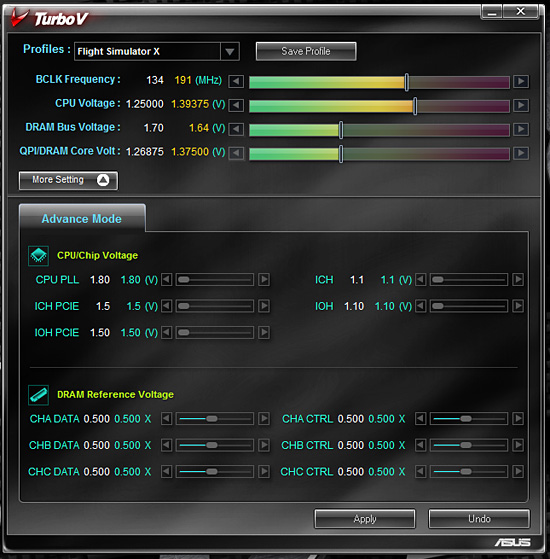
TurboV is ASUS' latest Windows based overclocking utility that features the ability to change most major BIOS settings to improve overclocking rates. It features profiles and works quite well, provided the memory timings and CPU multiplier have been set up properly prior to entering Windows. We are still hopeful that one of the major suppliers will offer the same capabilities as AMD's AOD utility.
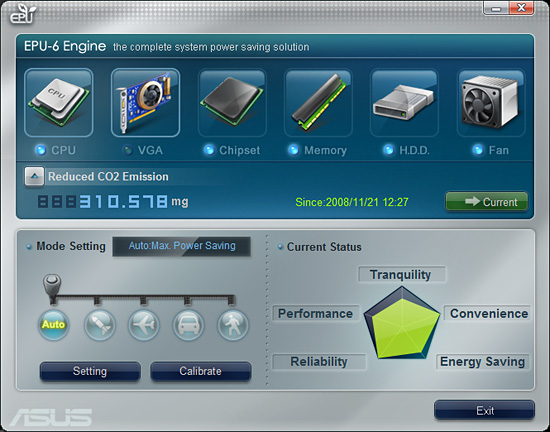
The P6T Deluxe features the EPU-6 power savings technology that can be accessed through the EPU software. The program offers five different modes or levels of energy savings. After hours of testing each setting, we found that leaving the application on Auto with a proper calibration worked best. Utilizing EPU-6 resulted in a power savings of 5W at both idle and load settings.
















78 Comments
View All Comments
MarchTheMonth - Friday, December 5, 2008 - link
Let me just say this, i haven't read through the entire article yet (i'm on only the first page still), and for any motherboard maker to focus strictly on extreme overclocks is just stupid to me.I bought my system the day the core i7 was released, got the i7 920, asus mobo, and 6GB of memory (and honestly, I think most users buy 6GB of memory, i really dont think many people get 3GB), and i couldn't overclock because the only HSF i had was the stock one, and at 100% cpu usage, my processor was reaching 96-100C after 3 minutes. I dumbled down my usage to make sure that nothing was making the computer run above 80, and now that i have a noctua HSF, i havent seen anything above 65C (even with my overclock of only 3.33Ghz).
My point is, if all my mobo could do out of the box was do extreme overlocks and run really high scores in synthetic program X, I would have been pissed. This is my main system, I expect it to be 24/7/365 stable, and I expect the mobo makers to make a product to provide this.
bob4432 - Friday, December 5, 2008 - link
i don't care about superpi scores if my $300 m/b can't do prime95 for 1hr. reliability is key - number 1 importance.i have many friends that are always buying top of the line m/bs and when we game, they are always the first to drop out as their machines have crashed. my 1-2gen old chipsets that at may offer crossfire/sli or a raid able southbridge are always bulletproof and i just keep on gaming.
in reality, nobody really cares if your machine is 1-3% faster in either fps or superpi if the damn thing can't stay on for any amount of time or only 60% of its onboard items work.
good job to you guys for geting this point across, and it is nearly criminal that you have to talk to them nearly 1000 times to get stuff resolved, utterly ridiculous.
Prozin - Friday, December 5, 2008 - link
I am very impressed that somebody has finally addressed this issue because in my opinion this has been going on for a while now. The trend in the industry seems to be clear, many of the larger companies seem to be not only advertising their products overclocking abilities but also getting on board with standout people in the overclocking community. Keeping with your article I won't mention any names here but the marketing strategy seems to have paid off, but at the expense of working products unfortunately!As you mentioned in your article (and I agree) these companies should focus on at least getting the standard features working correctly before insuring that the motherboard will boot at FSB speeds in access of 600Mhz! Its seems to me that once they get all their features (at least the advertised features) working properly they could focus their time and energy on the motherboard's overclocking ability without having to worry about the multitude of RMA's because of non-boot issues or drives not being identified.
Unfortunately I'm not able to articulate my thoughts as well as you guys did but I think its great your changing your review process to help industry focus more on releasing a fully working product before releasing a product that can overclock well at the expense of everything else. Please keep up the great work because consumers like myself will be the first ones to benefit from it!
Degloriath - Friday, December 5, 2008 - link
Something seems wrong with this article, interesting as it is, there's multiple broken image links and the next page link breaks. Just thought I should give you an early heads up!sciwizam - Friday, December 5, 2008 - link
"(What do you think about doing this) (listing out problems encountered is a good idea, not crazy about the thank you Gary,but that is just me)"Notes?
Gary Key - Friday, December 5, 2008 - link
The rough draft went up instead of the final article, it is correct now. :)trailertrash - Sunday, December 7, 2008 - link
i just ordered the asus p6t mobo an 6 meg of corsair 3 chan. ram. after reading that the 3rd sticks not seen by vista 64 i felt a pain in my gut but after looking around people have fixed the issue by flashing the bios to 0804.P.s. i hope its that simple
TheBeagle - Saturday, December 6, 2008 - link
Gary,Once again you have done a very good service of objectively reviewing and evaluating the latest batch of high-end boards - Well Done! As for any minor editorial/typo annoyances, just ignore them for the most part, and fix the ones you choose in due course. Overall, it's an excellent review, and worthy of publication on AnandTech's front page. And for those who might criticize any portion of it - just have them post THEIR comprehensive review so we can all compare those editorial products.
Best regards and Merry Christmas! TheBeagle